Content
Badan heart-leaved is a perennial herb with decorative qualities and medicinal properties. Such a flower has become widespread, as it adapts well to almost any climatic conditions. Every gardener will be able to grow badan on his site if he follows a number of rules and practical recommendations.
Healing properties
Many varieties of badan cordifolia are used as raw materials for the manufacture of medicines. Moreover, the plant is used not only in folk medicine, but also in pharmaceuticals.
The beneficial properties of bergenia cordifolia are explained by the corresponding chemical composition. Rhizomes are especially valuable. They contain tannins, fructose, ascorbic acid and vitamin A.
Preparations made on the basis of medicinal varieties of bergenia cordifolia have a hemostatic and anti-inflammatory effect. Also, the plant has a moderate hypotensive effect, lowers blood pressure.
Varieties with photos
Bergenia Cordifolia in Latin is a short, long flowering plant. The appearance directly depends on the variety. More than 40 natural and hybrid species of badan are known. Below are the most popular among domestic gardeners.
Cordifolia (Bergenia Cordifolia)
This is a classic variety used in landscaping. The height of the bushes of bergenia cordifolia Bergenia Cordifolia averages 40 cm.The name is associated with the characteristic shape of the foliage.
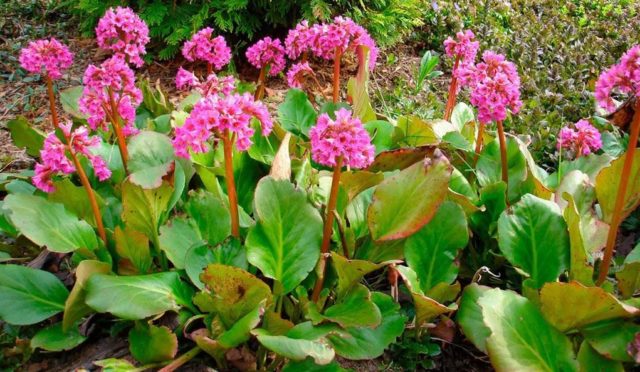
Budanus cordifolia blooms in late May and early April and lasts 3 weeks
The color of the foliage depends on the planting site. In well-lit areas, they are lighter, while in partial shade they can be dark green in color.
During the flowering period, numerous small bell-shaped flowers appear on the heart-leaved berry. They group together, forming panicles at the end of elongated peduncles. Their number on one bush varies.
The decorative properties of the Kordifolia variety are preserved throughout the season. After flowering, bushes of berry-leaved berry plant greenery in the area. The leaves retain their color until the beginning of autumn, and later turn red. In this form, they endure all winter.
Badan Rotblum
Bergenia Cordifiola Rotblum (red flowering) is a perennial undersized shrub. The height of the bush is 40 cm. It has soft, round or heart-shaped dark green leaves. They are collected in a basal rosette on a leafless stem.
During the flowering period, bell-shaped pink flowers appear. Their diameter does not exceed 1 cm. They form thyroid, slightly inclined inflorescences. This variety usually blooms in May. But the flowering period can shift by 1-2 weeks and last up to 20 days.
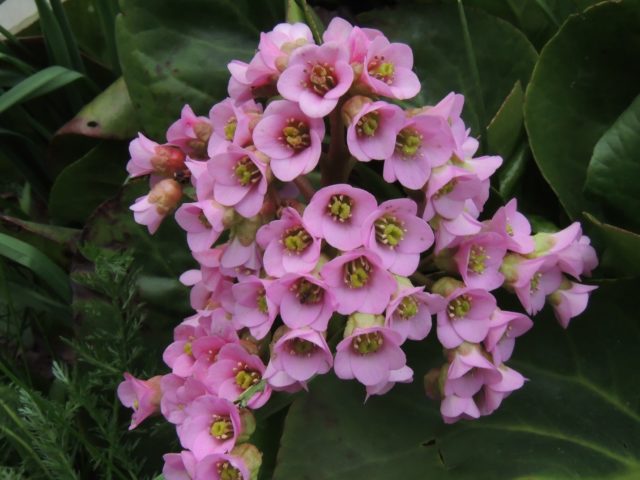
In the shade, the heart-leaved incense Rotblum grows slower than in the sun
The presented variety tolerates cold well. In winter, the bush is covered with its own leaves, which protect the roots from freezing. Also berry-leaved Rotblum is resistant to short-term drought.
the Red Star
This is a domestic variety of heart-leaved bergenia. Bush up to 50 cm high with long thick creeping stems. Leaves are leathery, dark green, slightly wavy at the edges. They retain their color until the beginning of autumn, later they begin to blush.
Like other types of heart-leaved incense, the red star cultivar blooms in May. Carmine-pink bell-shaped flowers appear on the bushes, forming inclined brushes.
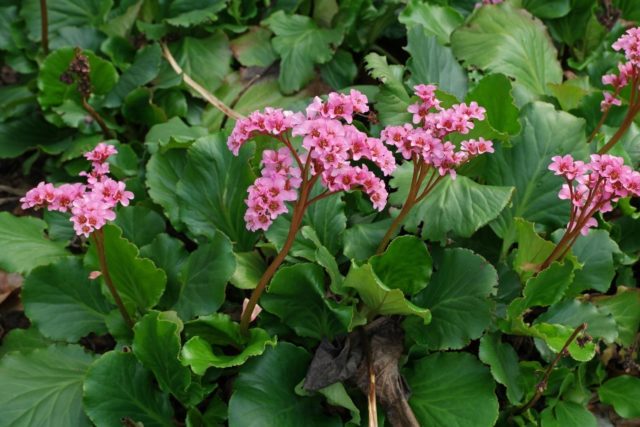
The Krasnaya Zvezda variety blooms for up to 1 month
The variety is cold-resistant, not susceptible to diseases and pests. However, the heart-leaved incense is in need of nutritious soil. It should be moist, but no liquid stagnation.
Beauty
Bergenia Cordifiola Red Beauty is an early flowering ornamental plant. They are actively used in landscape design when creating flower arrangements, as well as for single planting. It goes well with astilbe, daylilies, aquilegia.
The height of the bushes is up to 50 cm. It has dense dark green heart-shaped leaves.
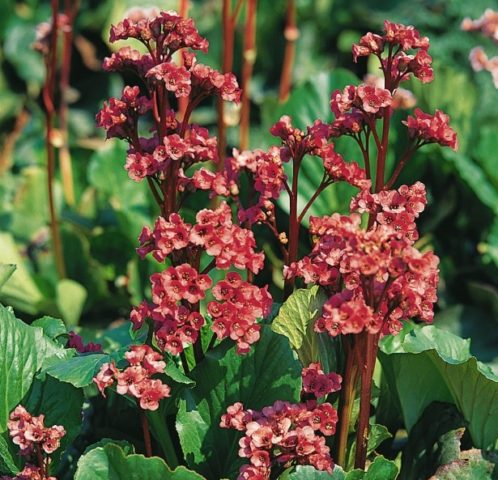
During the flowering period, the heart-leaved berry is covered with red small flowers that form panicles
The decorative properties are preserved even when the buds wither. The plant remains green until late autumn, provided that it is planted in a shaded area. It is not recommended to grow such a variety in the sun, since it does not grow lush.
Baby Doll
The hybrid variety Bergenia Cardifolia Baby Doll is an unpretentious undersized perennial. The bush has a developed root system, so it grows well on almost all types of soil. The stems of a heart-shaped bergamot Baby Dol are red.
This variety belongs to early flowering plants. It usually starts in early May and lasts until June. On tall shoots, inflorescences are formed with pale pink flowers and bright red pre-flowers.
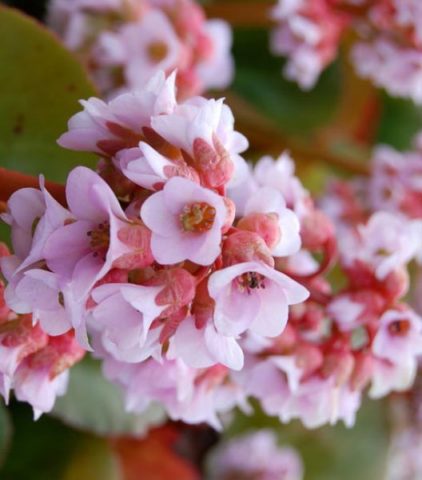
The flowering intensity of the variety depends on the moisture and acidity of the soil.
The presented heart-leaved variety does not require special attention. For full growth, it is necessary to ensure regular watering, as well as monitor the density of the soil.
Lilac Rose (Lilac Rose)
Bergenia cordifiola Lilac Rose got its name from the color of its flowers. Height - from 30 to 45 cm. Before flowering, the bush is short and contains only a stem with a large number of large leathery dark green leaves. By the fall, they turn red and remain so throughout the winter.
During the flowering period, the heart-leaved incense is covered with lilac flowers with a red core, which are collected in dense brushes. The first buds open in mid-April. In some regions, flowering begins in May.
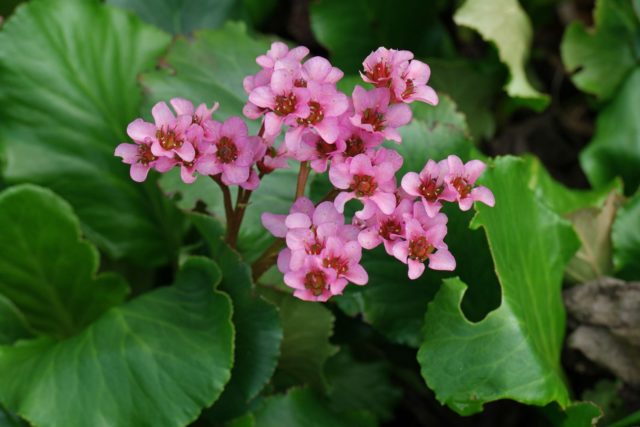
Heart-leaved incense Lilac Rose prefers shady areas with well-drained soil
The presented variety tolerates adverse weather conditions well. Only young specimens that have recently been transplanted into open ground need special care.
Autumn flower (Herbstblute)
A hybrid variety bred by German breeders. Bergenia Cardifiola Herbstblute badan has a unique color. The leaves are dark green. Stems and pre-flowers are dark red. The flowers are pale pink, forming small brushes.

Flowering begins in June and lasts up to 4 weeks
The hybrid variety is not susceptible to disease and pest attacks. The flower tolerates short-term drought well. Due to these advantages, this type of bergenia is often recommended for novice gardeners.
Reproduction
Badan cordifolia has a developed root system. Therefore, adult specimens tolerate division well.
Algorithm of the procedure:
- Choose a healthy and mature shrub.
- The bush is dug in from all sides.
- A root cut with 3 or more buds is separated.
- The delenka is planted in a new place, and the mother bush is buried.
Another breeding option is cuttings. A healthy, preferably young shoot is separated from the plant. Buds are removed from it, if they have already formed, as well as lateral shoots. You can leave 1-2 small sheets.
The stalk is placed in water for 7-10 days. During this period, the shoot must sprout. In the future, it is planted in a previously prepared container with soil.
Growing heart-leaved incense from seeds
For planting rare varieties, seedlings are pre-sown. To do this, use a nutritious, well-moistened garden soil. You can also use separate seedling cassettes for this purpose.
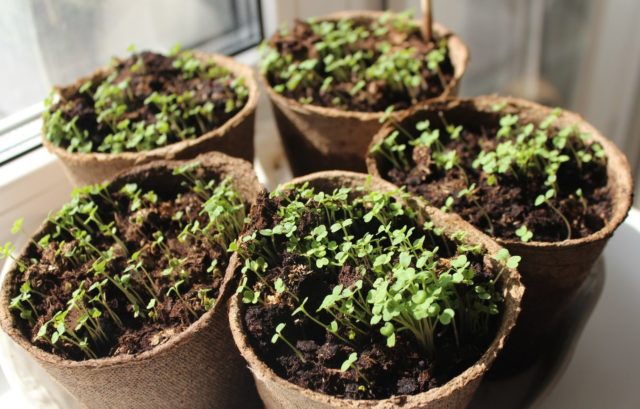
A good option for sowing badan seeds are peat cups and pots
Sowing seeds:
- Soak the planting material in a solution of potassium permanganate.
- Fill the seedling container with soil.
- Make indentations 5 mm.
- Place the seeds inside at a distance of 5-6 mm.
- Spray from a spray bottle.
- Cover the container with plastic wrap.
Seedlings should be kept at a temperature of 16-18 degrees in a room with moderate air humidity. Under such conditions, the seeds of bergenia cordifolia germinate in 4 weeks.
Seedlings with three leaves must be dived. They are seated in separate containers and are no longer covered with foil.
Landing
Transferring seedlings to open ground is easy even for novice gardeners. To do this, just use the instructions.
When to plant
Sowing seeds for seedlings, as a rule, is carried out in early spring. Transplanting seedlings into the ground can be performed at the end of May or in June.
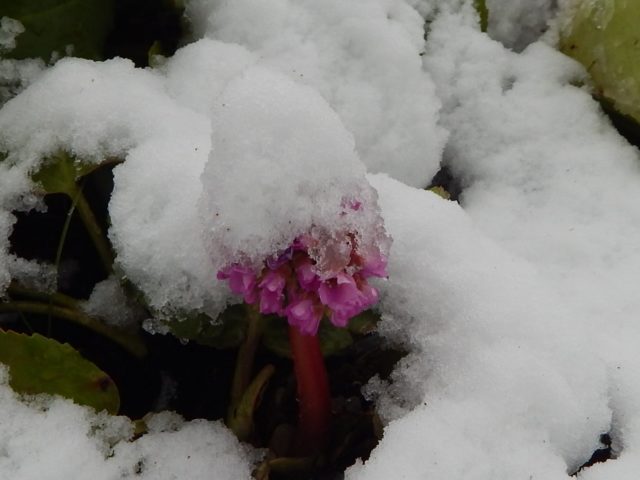
Some varieties of badan begin to bloom even in winter.
Experienced gardeners recommend transferring seedlings to open ground in August. At the same time, the largest leaves should be removed from it so that they do not waste nutrients from the soil. With such a planting, the bush will immediately begin to take root and will have time to adapt to a new place before the onset of cold weather.
Planting site and soil preparation
Badan cordifolia is not picky about growing conditions. It does well in almost all soil types, provided they meet several criteria:
- looseness;
- breathability;
- moderate humidity;
- neutral acidity.
The composition of the soil is of no fundamental importance. It can be sandy or clayey. Most varieties of badan do not need a lot of nutrients. However, when planting, it is recommended to add organic matter to fertilize the flower during the period of adaptation to new conditions.
The plant is best planted in partial shade. In the sun, leaves and stems can wilt without additional watering. In the shade, the bush often slows down growth, which makes it look less beautiful.
How to plant
Planting is carried out in accordance with simple instructions. Beforehand, you need to prepare a comfortable gardening tool and work gloves to protect your hands.
Landing Algorithm:
- Dig holes 25-30 cm deep.
- Place river sand or crushed stone at the bottom as drainage.
- Cover with a layer of garden soil mixed with compost and peat.
- Place a seedling with a root ball in the hole.
- Sprinkle it with soil.
- Watering.
For 1 sq. m of plot, it is recommended to plant no more than 6 plants. The distance between them must be at least 20 cm.
Care
For normal growth and regular flowering, a minimum set of activities is required. Badan is cordial unpretentious, therefore it can remain without care for a long time.
Periodically required:
- weed removal;
- watering;
- pruning;
- loosening the soil;
- pest control.
Such procedures will not complicate even beginner gardeners. The main rule is that all activities must be timely.
Watering and feeding
The plant does not need a lot of liquid. In spring and early summer, it does not need to be watered often. Increase the volume of water only on dry days. Moisturize 1-2 times a week.
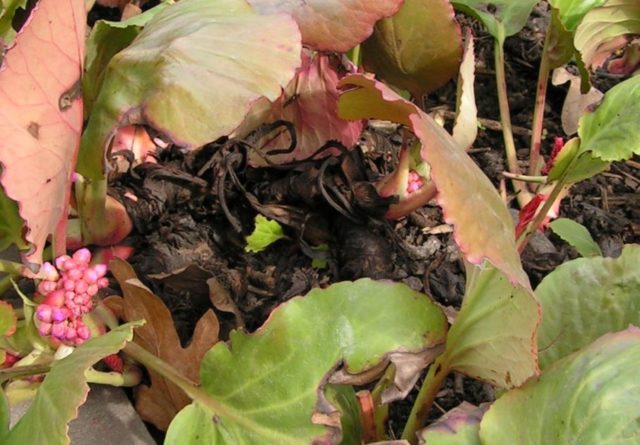
All varieties of badan react negatively to stagnant water in the soil.
Plant feeding is recommended in the spring. Compost, humus or peat are added to the soil next to the flower. In summer, you can use tree bark, sawdust or dry foliage as fertilizer, which serve as mulch and retain moisture.
Pruning and preparing for winter
In the fall, when the leaves begin to fall, the peduncles must be removed from the plant. Keep the shoots below. It is also not recommended to cut the foliage, since the plant closes with it before the onset of cold weather.
Most varieties of heart-leaved badan are winter hardiness. However, young plants are best sheltered from frost under a layer of straw, dry foliage, or needles. The use of film material is allowed, provided that it is breathable.
Diseases and pests
Some varieties are prone to ramularia. Pathology is accompanied by leaf spot. The affected parts of the plant must be removed. The remaining bush is treated with a fungicide to prevent relapse.
Among the common pests of bergenia are nematodes and pennies. To prevent damage, it is recommended to spray the bushes with insecticides for prophylactic purposes. It is held in the spring. Also, the processing is carried out when signs of damage appear.
Why does not it bloom
There are a number of reasons why flower stalks are not tied on berry. Because of this, flowering does not occur and the plant remains green until the end of the season.
Main reasons:
- lack of sunlight;
- the plant is grown from seeds;
- the bush was recently transplanted;
- specimens are planted close to each other;
- the presence of diseases.
In the absence of flowering, you need to identify the cause and eliminate it. Then the plant will be able to fully fulfill its decorative function, decorating the site.
Conclusion
Badan hearty is a perennial, characterized by unpretentiousness and ease of care. Numerous varieties of such a plant are actively used in landscape design to create flower arrangements. The plant tolerates any weather conditions well and is not picky about the composition of the soil. Therefore, it is ideal for beginners as well as experienced gardeners.








